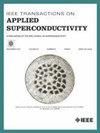Prototyping and Test of the “Canis” HTS Planar Coil Array for Stellarator Field Shaping
IF 1.8
3区 物理与天体物理
Q3 ENGINEERING, ELECTRICAL & ELECTRONIC
引用次数: 0
Abstract
Thea Energy, Inc. is currently developing the “Eos” planar coil stellarator, the company’s first integrated fusion system capable of forming optimized stellarator magnetic fields without complex and costly modular coils. To demonstrate the field shaping capability required to enable Eos, Thea Energy designed, constructed, and tested the “Canis” 3 × 3 array of high-temperature superconductor (HTS) planar shaping coils after successfully demonstrating a single shaping coil prototype. Through the Canis 3 × 3 magnet array program, Thea Energy manufactured nine HTS shaping coils and developed the cryogenic test and measurement infrastructure necessary to validate the array’s performance. Thea Energy operated the array at 20 K, generating several stellarator-relevant magnetic field shapes and demonstrating closed-loop field control of the superconducting magnets to within 1% of predicted field, a margin of error acceptable for operation of an integrated stellarator. The Canis magnet array test campaign provides a proof of concept for HTS planar shaping coils as a viable approach to confining stellarator plasmas.仿星器场整形用“Canis”型高温超导平面线圈阵列的原型设计与试验
Thea Energy, Inc.目前正在开发“Eos”平面线圈仿星器,这是该公司第一个集成聚变系统,能够形成优化的仿星器磁场,而不需要复杂和昂贵的模块化线圈。为了演示实现Eos所需的现场整形能力,Thea Energy在成功演示了单个整形线圈原型后,设计、建造并测试了“Canis”3x3高温超导体(HTS)平面整形线圈阵列。通过Canis 3 × 3磁体阵列项目,Thea Energy制造了9个高温超导成形线圈,并开发了验证阵列性能所需的低温测试和测量基础设施。Thea Energy在20 K的温度下操作阵列,产生了几个与仿星器相关的磁场形状,并演示了超导磁体的闭环场控制,控制范围在预测场的1%以内,这是一个集成仿星器操作可以接受的误差范围。Canis磁体阵列测试活动为高温超导平面整形线圈作为限制仿星等离子体的可行方法提供了概念证明。
本文章由计算机程序翻译,如有差异,请以英文原文为准。
求助全文
约1分钟内获得全文
求助全文
来源期刊

IEEE Transactions on Applied Superconductivity
工程技术-工程:电子与电气
CiteScore
3.50
自引率
33.30%
发文量
650
审稿时长
2.3 months
期刊介绍:
IEEE Transactions on Applied Superconductivity (TAS) contains articles on the applications of superconductivity and other relevant technology. Electronic applications include analog and digital circuits employing thin films and active devices such as Josephson junctions. Large scale applications include magnets for power applications such as motors and generators, for magnetic resonance, for accelerators, and cable applications such as power transmission.
 求助内容:
求助内容: 应助结果提醒方式:
应助结果提醒方式:


